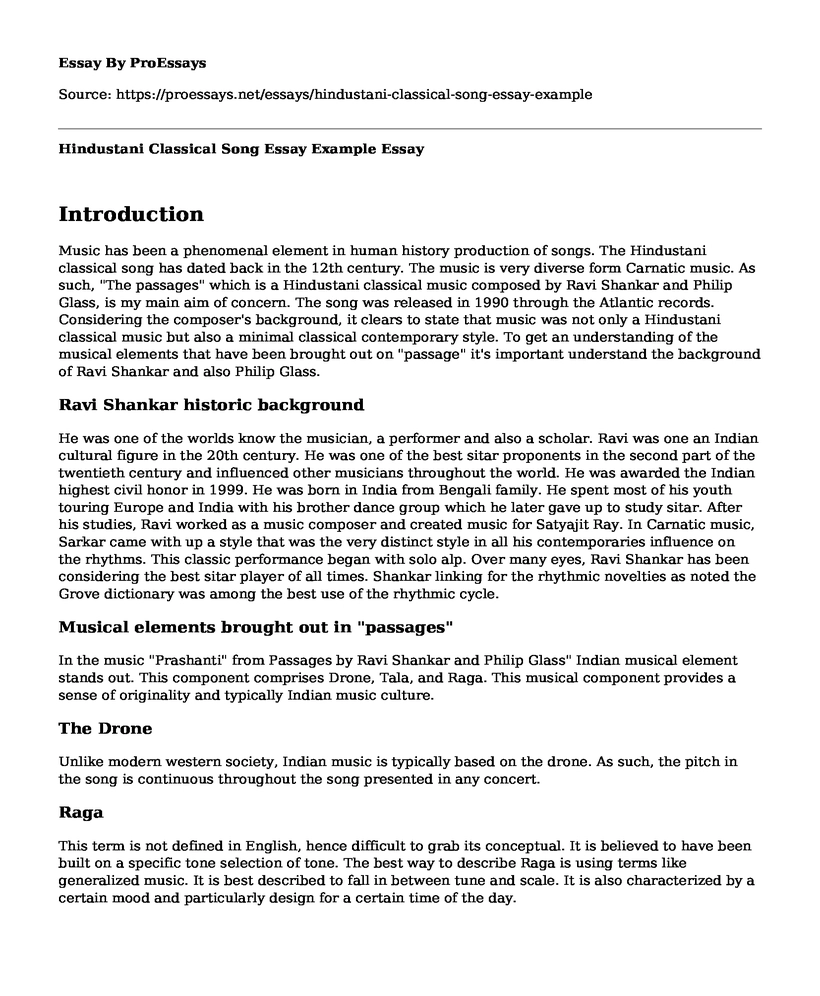Introduction
Music has been a phenomenal element in human history production of songs. The Hindustani classical song has dated back in the 12th century. The music is very diverse form Carnatic music. As such, "The passages" which is a Hindustani classical music composed by Ravi Shankar and Philip Glass, is my main aim of concern. The song was released in 1990 through the Atlantic records. Considering the composer's background, it clears to state that music was not only a Hindustani classical music but also a minimal classical contemporary style. To get an understanding of the musical elements that have been brought out on "passage" it's important understand the background of Ravi Shankar and also Philip Glass.
Ravi Shankar historic background
He was one of the worlds know the musician, a performer and also a scholar. Ravi was one an Indian cultural figure in the 20th century. He was one of the best sitar proponents in the second part of the twentieth century and influenced other musicians throughout the world. He was awarded the Indian highest civil honor in 1999. He was born in India from Bengali family. He spent most of his youth touring Europe and India with his brother dance group which he later gave up to study sitar. After his studies, Ravi worked as a music composer and created music for Satyajit Ray. In Carnatic music, Sarkar came with up a style that was the very distinct style in all his contemporaries influence on the rhythms. This classic performance began with solo alp. Over many eyes, Ravi Shankar has been considering the best sitar player of all times. Shankar linking for the rhythmic novelties as noted the Grove dictionary was among the best use of the rhythmic cycle.
Musical elements brought out in "passages"
In the music "Prashanti" from Passages by Ravi Shankar and Philip Glass" Indian musical element stands out. This component comprises Drone, Tala, and Raga. This musical component provides a sense of originality and typically Indian music culture.
The Drone
Unlike modern western society, Indian music is typically based on the drone. As such, the pitch in the song is continuous throughout the song presented in any concert.
Raga
This term is not defined in English, hence difficult to grab its conceptual. It is believed to have been built on a specific tone selection of tone. The best way to describe Raga is using terms like generalized music. It is best described to fall in between tune and scale. It is also characterized by a certain mood and particularly design for a certain time of the day.
Tala
In contrast to raga which is a melody-based element, Tala is majorly based on the rhythmic structural component. As I listen to "Prashanti from Passages", I can clearly point out the subdivide beats in the music cycles. The shift in between phase gives a clear consent of melody.
Foreign Musical element as per "Prashanti from Passages" song
Harmony principle
At some point of the song, there is the incorporation of harmony. Harmonic principle intertwined in some part of the drone. I could clearly point out this because it should be much continuous pith, but at some points, there are bridges of melody and tune transition.
Other musical influences
Beats
In beats, the pulse is created to form a rhythmic unit of time. Therefore, it would have been better to include in between Tala as a shift between melody circle and beats breaks would bring a more pleasing rhythm.
Tempo
The speed of the beat is what defines the kind of music the song falls into. Therefore, in the song "Prashanti from Passages" the pace would adjust to moderate tempo in purpose to modernize according to modern westernize society.
Overall effect of the musical fusion
Indian musical fusion has long preserved it cultural song tunes and melody. It has benefit factor to a modern global community having a taste of what early society use to produce. To add on that, it also preserves the instruments used to produces this ancient tunes and melodies. Therefore, it made people appreciate their culture.
Work cited
van Straaten, Eva-Maria Alexandra, Charissa Arlette Granger, and Poupak Amirazodi. Listening Out for Sangit Encounters: Dynamics of Knowledge and Power in Hindustani Classical Instrumental Music. Diss. Georg-August-Universitat Gottingen, 2018.
Cite this page
Hindustani Classical Song Essay Example. (2022, Oct 08). Retrieved from https://proessays.net/essays/hindustani-classical-song-essay-example
If you are the original author of this essay and no longer wish to have it published on the ProEssays website, please click below to request its removal:
- The Judge's Wife vs Act of Revenge Comparative Essay on Literature
- Analysis of Rembrandt's Paintings - Paper Example
- Tracing the Evolution of Art: A Study of Five Art History Movements
- Essay Example on Romance and Revolution: A Journey of Self-Discovery in 'As You Like It'
- Essay Sample on Exploring the Hanukkah Lamp & Kitchen Ball at North Carolina Museum of Art
- Movie Analysis Essay on Big Short
- Paper Example on Police Procedurals: Evolving in American TV Over Decades







